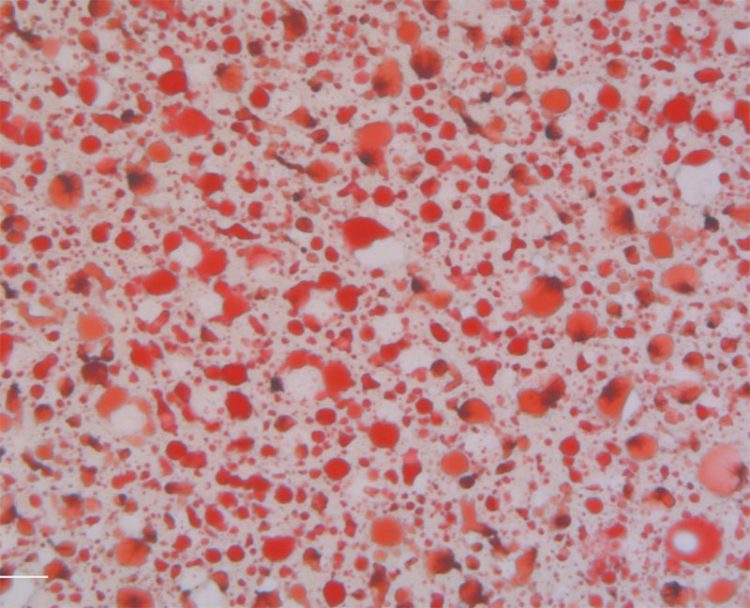Liver Cancer: Lipid Synthesis Promotes Tumor Formation

Lipid accumulation (red) in liver tissue promotes development of hepatocellular carcinoma. Biozentrum, University of Basel
In Switzerland, about 650 new cases of liver cancer are diagnosed every year. The incidence of the malignant and aggressive liver cell carcinoma has doubled in the last 20 years, especially in developed countries. One possible reason for this is the increase in obesity and diabetes.
The scientists led by Prof. Michael N. Hall at the Biozentrum, University of Basel, and Prof. Howard Riezman, University of Geneva, have gained new insights into tumor development and disease progression.
In mouse models and patient samples, they have demonstrated that the growth regulator mTOR – mammalian target of rapamycin – promotes de novo lipid synthesis and thus tumorigenesis. The accumulation of fatty acids and lipids in the liver is one of the major causes of hepatocellular carcinoma.
The liver: Detoxifier and energy supplier
“The liver is in a way our body’s kitchen,” explains Yakir Guri, medical doctor and first author of the study. “It stores and recycles nutrients, produces hormone precursors and detoxifies the body by eliminating harmful substances, such as drugs and alcohol.” Not only excessive alcohol consumption, but also obesity and diabetes combined with lack of exercise can damage the liver.
A first asymptomatic syndrome is so-called “fatty liver”, which may cause inflammation that can progress to hepatocellular carcinoma (HCC). The aggressive and rapidly proliferating HCC cells ultimately destroy the surrounding healthy liver tissue, leading to liver failure.
Hepatocellular carcinoma: mTOR activation promotes tumorigenesis
The researchers initially investigated the progression of the disease in a mouse model. For this purpose, they constitutively activated mTOR specifically in liver cells. “We already knew that mTOR is involved in tumor development as it centrally controls cell growth. However, in the case of HCC we did not know which downstream metabolic and signaling pathways are affected,” says Guri.
The researchers have now discovered that mTORC2 – mTOR forms two protein complexes termed mTORC1 and mTORC2 – promotes the new synthesis of fatty acids and certain lipids. Most people do not realize that our body contains more lipid species than genes. It is assumed that there are thousands of different types,” says Guri. “Together with Howard Riezman’s team, we have been able to analyze a broad spectrum of such lipids.”
Lipids: Synthesis of lipids is required for tumor development
In hepatocytes, mTORC2 stimulates in particular the production of two lipid species important for cell growth: sphingolipids and cardiolipins. The first are structural components of cell membranes, which have to be continuously supplied in rapidly proliferating cells. Cardiolipins are located in the cellular powerhouse, the mitochondria, and are involved in energy production. By enhancing cardiolipin synthesis, the energy-hungry tumor cells ensure their energy supply. “Cancer cells depend on the new synthesis of fatty acids and lipids; if you turn off the tap, you stop the development of tumors.”
Patients: Analysis of liver biopsies confirms correlation
Analysis of tissue samples from patients with HCC confirmed the observations made in the mouse model. mTORC2 and its signaling pathways, which promote de novo synthesis of fatty acids and lipids, are also activated in tumor samples from patients.
Thus, the protein complex plays a critical role in the progression of benign “fatty liver” to aggressive HCC. The study provides important insights for the development of potential therapeutic interventions, as it shows that targeted lipogenesis inhibitors may have the potential to prevent tumor development.
The project has been funded by the European Research Council (ERC), the Swiss Cancer Research Foundation and the Swiss National Centre of Competence in Research (NCCR) Chemical Biology.
Original article
Yakir Guri, Marco Colombi, Eva Dazert, Sravanth K. Hindupur, Jason Roszik, Suzette Moes, Paul Jenoe, Markus H. Heim, Isabelle Riezman, Howard Riezman and Michael N. Hall
mTORC2 promotes tumorigenesis via lipid synthesis
Cancer Cell (2017), doi: 10.1016/j.ccell.2017.11.011
Further Information
• Prof. Michael Hall, University of Basel, Biozentrum, phone +41 61 207 21 50, email: m.hall@unibas.ch
• Dr. Katrin Bühler, University of Basel, Biozentrum, Communications, phone +41 61 207 09 74, email: katrin.buehler@unibas.ch
Media Contact
More Information:
http://www.unibas.chAll latest news from the category: Life Sciences and Chemistry
Articles and reports from the Life Sciences and chemistry area deal with applied and basic research into modern biology, chemistry and human medicine.
Valuable information can be found on a range of life sciences fields including bacteriology, biochemistry, bionics, bioinformatics, biophysics, biotechnology, genetics, geobotany, human biology, marine biology, microbiology, molecular biology, cellular biology, zoology, bioinorganic chemistry, microchemistry and environmental chemistry.
Newest articles

First-of-its-kind study uses remote sensing to monitor plastic debris in rivers and lakes
Remote sensing creates a cost-effective solution to monitoring plastic pollution. A first-of-its-kind study from researchers at the University of Minnesota Twin Cities shows how remote sensing can help monitor and…

Laser-based artificial neuron mimics nerve cell functions at lightning speed
With a processing speed a billion times faster than nature, chip-based laser neuron could help advance AI tasks such as pattern recognition and sequence prediction. Researchers have developed a laser-based…

Optimising the processing of plastic waste
Just one look in the yellow bin reveals a colourful jumble of different types of plastic. However, the purer and more uniform plastic waste is, the easier it is to…



